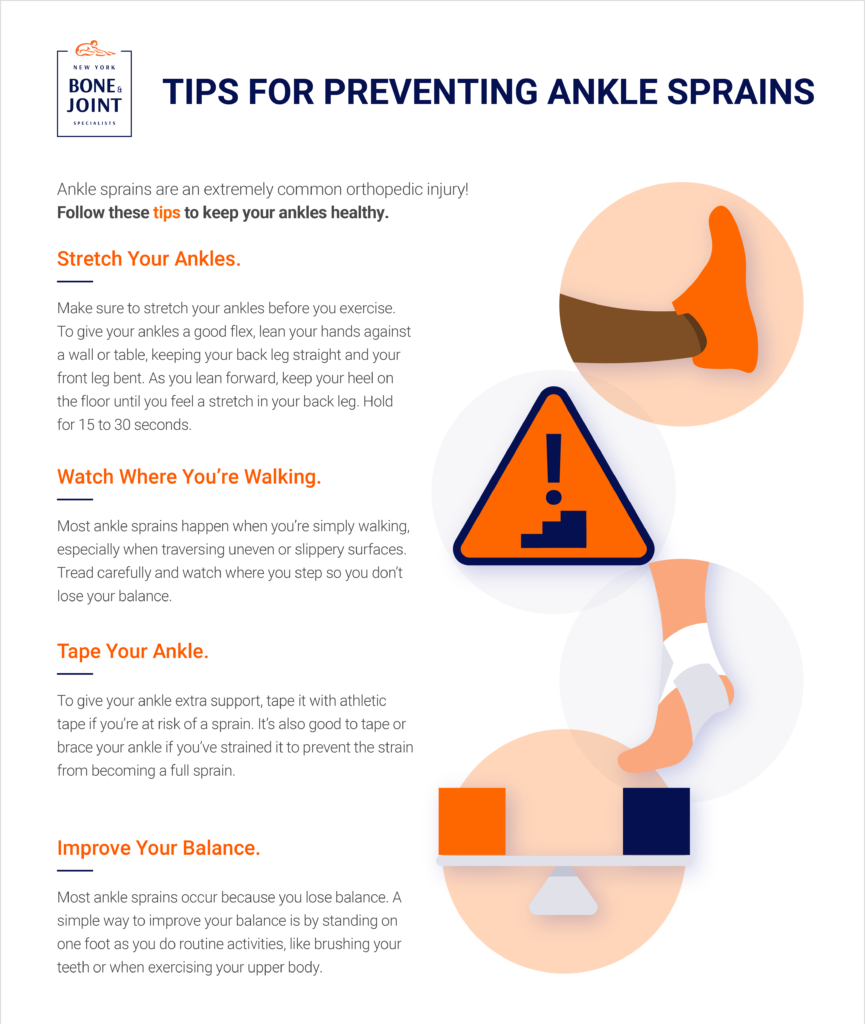Ankle sprains are some of the most common and painful orthopedic injuries. But you can prevent ankle sprains if you’re careful! Learn how.
Ankle sprains make up some of the most common orthopedic injuries. In fact, one study estimated that 2 million people suffer severe ankle sprains each year. The injury frequently occurs during athletic workouts, such as basketball or tennis, but it isn’t limited to just that. You can easily sprain your ankle during everyday activities due to anything from a slip on a sidewalk to running up stairs where you wrench the joint into an unnatural position. Read on to learn more about ankle sprains and how to prevent them.
What Are Ankle Sprains?
While you may think that ankle sprains are related to the bones in your leg, they actually have to do with the ligaments that connect the bones in your ankle and give your joint stability. When you twist or jerk your ankle out of its normal position, the ligaments may slightly tear or completely rupture, leading to an ankle sprain and pain when you place your weight on your foot. Other common symptoms include swelling and bruising as well as a limited range of motion in the ankle.
While ankle sprains are typically not the most serious orthopedic injury, they can have serious consequences if you aren’t careful. At the very least, ankle sprains are painful and can severely restrict your mobility. The best way to deal with those symptoms is to take precautions to prevent a sprain in the first place.
6 Ways to Prevent Ankle Sprains
Improve Your Balance. Most ankle sprains occur because you lose balance. A simple way to improve your balance is by standing on one foot as you do routine activities, like brushing your teeth or when exercising your upper body. Make sure to do this on both legs!
Strengthen Your Ankles. As you concentrate on building up your leg muscles, it’s easy to neglect your ankle muscles. Tone your ankle muscles using a resistance band tied in a large loop. With the band, sit in a chair and place one end of the loop around the leg of a heavy, stable chair or table. Loop the other end around your foot. Move your ankle out and up, and then in and up, always keeping the band tight. Another exercise to try is to keep the band looped over your foot and press your foot down against the resistance of the rubble band, keeping your heel on the floor. The action is similar to pedaling the accelerator of your car.
Stretch Your Ankles. Make sure to stretch your ankles before you exercise. To give your ankles a good flex, lean your hands against a wall or table, keeping your back leg straight and your front leg bent. As you lean forward, keep your heel on the floor until you feel a stretch in your back leg. Hold for 15 to 30 seconds. Then, bend your back leg slightly and stretch for 15 to 30 seconds with both heels on the floor.
Tape Your Ankle. To give your ankle extra support, tape it with athletic tape if you’re at risk of a sprain. A physical therapist or trainer can show you the proper way to tape your ankle. Or, you can use an ankle brace. Today’s ankle braces allow for more mobility, so you can choose one that is comfortable and supportive. It’s particularly good to tape or brace your ankle if you’ve strained it to prevent the strain from becoming a full sprain.
Wear the Right Shoes. If you’re exercising or playing a sport, choose shoes that provide support while not being too restrictive. High-top shoes are often touted as a way to prevent ankle sprains — and they can be helpful — but some studies suggest they are not strong enough to support the ankle if the ligament is severely wrenched out of place. If you’re curious what shoes are best, talk to your orthopedist.
Watch Where You’re Walking. Most ankle sprains happen when you’re simply walking, especially when traversing uneven or slippery surfaces. Tread carefully and watch where you step so you don’t lose your balance.

Treating Ankle Sprains
Ankle sprains respond well to conservative methods. Treatments and the length of the treatment depend on the severity of the sprain. Mild sprains usually resolve in two weeks. More severe sprains may take longer to heal.
For ankle sprains, the first line of treatment is the RICE method: Rest, Icing, Compression, and Elevation. Working together, these actions should reduce pain and swelling. Over-the-counter pain medications can reduce the discomfort, as well.
If your ankle is painful, you should try to take as much weight off of it as possible. That may mean using crutches for a while. When the pain subsides, a physical therapy program designed to strengthen the ankle muscles, restore range of motion, and improve flexibility and stability is the recommended course of treatment.
Surgery is reserved only for cases of severe tears that don’t respond to conservative treatments. A surgeon can stabilize the ankle by reconstructing the ligament from other ligaments or tendons, but that is not typically recommended for ankle sprains.
Start Treating Your Ankle Sprains Today
At New York Bone & Joint Specialists, we treat a variety of orthopedic problems, including ankle sprains. We provide the latest in diagnostic techniques and will offer you several treatment options, from conservative methods like physical therapy to surgery, if necessary. Contact us today for a consultation.




